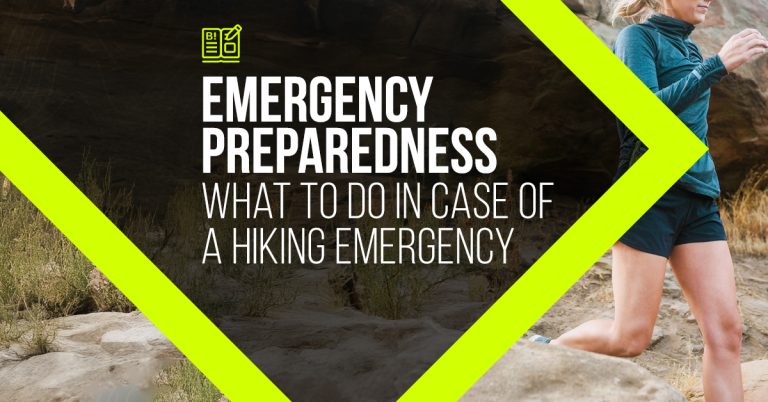
Emergency Preparedness: What to Do in Case of a Hiking Emergency
Posted on August 15, 2025
Hiking is one of the most rewarding ways to connect with nature, but it also comes with its share of risks and the potential to face a variety of different hiking emergencies. Whether you’re exploring a local trail or tackling a rugged backcountry route, being prepared for emergencies is essential. Here’s a guide on how to prepare for potential crises and what to do in the event of an emergency while you’re out in the wild.
Before You Go: Prepare and Plan
1. Research Your Route
Before hitting the trail, familiarize yourself with the area. Check trail maps, read recent trail reports, and understand the terrain and weather conditions. Knowing the difficulty level and potential hazards helps you assess your preparedness. The National Park Service makes a Trip Planning Guide available which can be used to help adequately prepare for trips ahead of time and minimize the possibility of encountering any hiking emergencies along the way.
2. Tell Someone Your Plans
Always inform a friend or family member about your hiking itinerary. Provide them with details like your starting point, expected return time, and route. This information is crucial if you need rescue assistance.
3. Pack an Emergency Kit
An emergency kit can be a lifesaver. Here’s what to include:
- First Aid Kit: Basic supplies for treating injuries.
- Navigation Tools: Map, compass, or GPS device.
- Food and Water: Extra snacks and a means to purify water.
- Multi-tool or Knife: Versatile tools for various situations.
- Firestarter: Waterproof matches or a lighter.
- Emergency Blanket: Compact and can retain body heat.
- Headlamp or Flashlight: With extra batteries for visibility.
- Whistle: To signal for help if needed.
4. Know Basic First Aid
Understanding first aid basics can help you respond effectively to injuries. Consider taking a first aid or wilderness first responder course to boost your confidence and skills.
During Your Hike: Stay Alert
1. Monitor Weather Conditions
Weather can change rapidly in the mountains. Keep an eye on the sky and be aware of any weather alerts. If storms approach, it may be wise to turn back.
2. Stick to the Trail
Staying on marked trails reduces the risk of getting lost and minimizes your impact on the environment. Straying from paths can lead to dangerous situations.
3. Listen to Your Body
Fatigue, dehydration, or illness can strike unexpectedly. If you start feeling unwell, take a break, hydrate, and assess your condition. Limit the potential for hiking emergencies by simply turning back rather than trying to push through when your health is at stake.
What to Do in an Emergency
1. Assess the Situation
Stay calm and assess the emergency. Is it a minor issue, like a sprained ankle, or something more serious, like a lost companion or severe weather conditions? Understanding the severity will guide your next steps.
2. Provide First Aid
If someone is injured, administer first aid if you’re able. Stop any bleeding, immobilize broken bones, and manage shock by keeping the person warm and calm. As a useful resource, the American Red Cross offers First Aid Classes.
3. Use Your Whistle
If you’re lost or need help, use your whistle to signal for assistance. Three short blasts is the universal signal for distress. Whistles are more effective than shouting, as they conserve your energy and carry further.
4. Navigate Back
If you’re lost, retrace your steps if safe to do so. Use your navigation tools to find your way back. Don’t hesitate to seek higher ground to get a better view of the terrain. In terms of effective navigation tools, check out the ACR Bivy Stick Satellite Communicator and Bivy Stick MESH (with Mesh Networking included) that feature two-way messaging, emergency SOS, GPS tracking, and location sharing.
5. Stay Put If Necessary
If you’re truly lost and unsure of the direction to take, it’s often best to stay put. This makes it easier for searchers to find you. Set up a visible signal—like a bright-colored tarp or a large “SOS” with rocks or branches.
After the Hike: Reflect and Learn
1. Debrief
Once you’re safely back home, take some time to reflect on the hike. What went well? What could have been done differently? Use this information to improve future outings.
2. Share Your Experience
If you encountered an emergency, share your experience with others. It can help raise awareness about the importance of preparedness and provide valuable lessons for fellow hikers.
Being prepared for hiking emergencies allows you to handle unforeseen situations with confidence. With the right planning and knowledge, you can enjoy the beauty of nature while staying safe. Remember, a great hike is not just about the destination, but also about being ready for whatever comes your way throughout the journey.